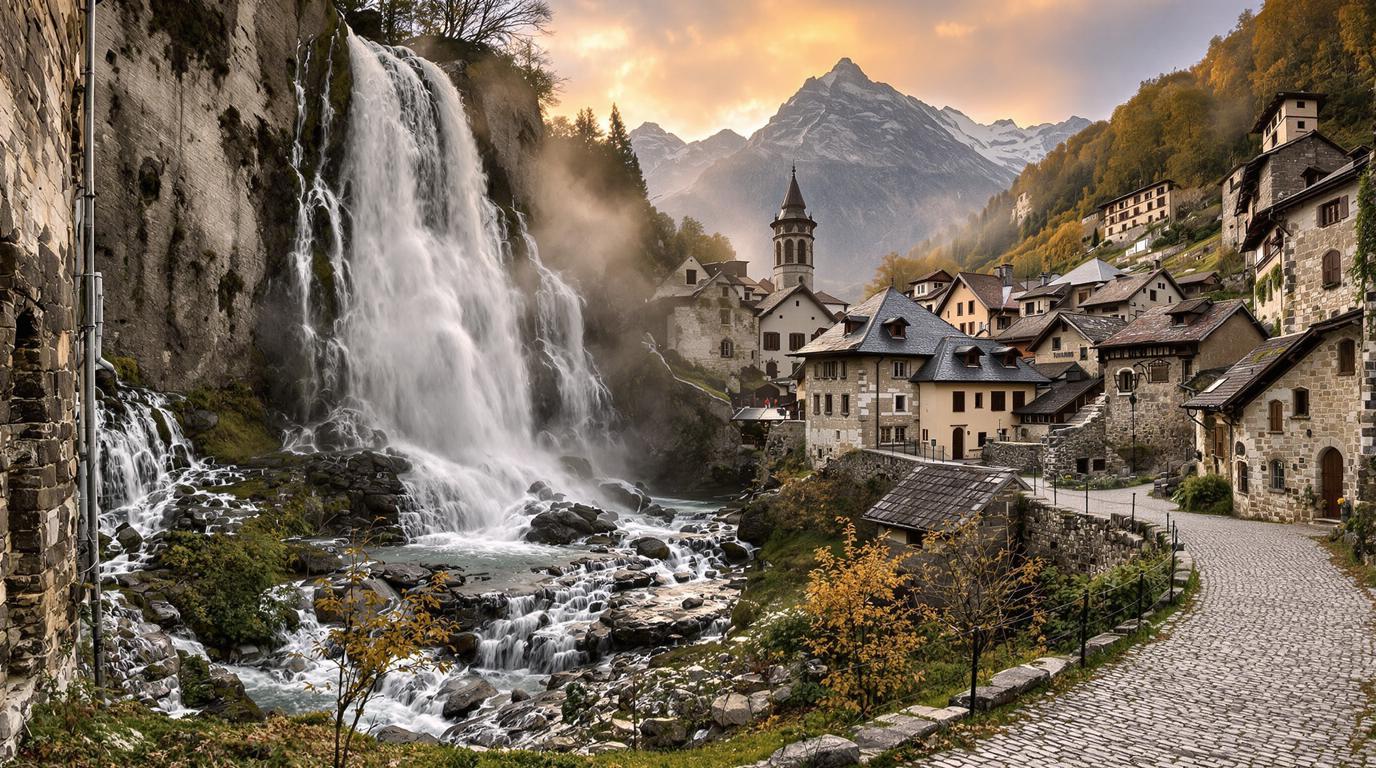Switzerland’s smallest villages are frozen in time, standing as living museums for travelers seeking authenticity. With populations under 100, these alpine hamlets offer a window into traditional Swiss life untouched by modern influence. From dramatic waterfalls to ancient stone architecture, these microcommunities preserve centuries of Alpine heritage while facing unique challenges in the modern world.
The 80-meter waterfall village that time forgot
Foroglio sits quietly in Ticino’s Bavona Valley, where just 60 residents live beside an 80-meter waterfall cascading dramatically near stone houses with slate roofs. Wander narrow cobblestone lanes that wind between buildings seemingly unchanged for centuries.
“Our village tells stories through every stone,” explains Maria Rossi, a lifelong resident. “The waterfall has been our constant companion through generations.”
Visitors can experience authentic Ticinese cuisine in traditional grotti – rustic taverns carved directly into mountainside rock – where cooking methods remain unchanged for hundreds of years.
The village offering cash to new residents
Albinen in Valais has been fighting population decline with an innovative approach – offering cash incentives to families willing to relocate. This alpine hamlet showcases Switzerland’s determination to preserve its traditional communities despite modern migration challenges.
With raw, unspoiled natural beauty surrounding traditional timber and stone architecture, Albinen provides an authentic mountain experience far removed from tourist hotspots. The village exists in perfect harmony with the dramatic alpine landscape that envelops it.
Stone alleys and traditional life in Sonogno
At the uppermost reaches of Valle Verzasca, Sonogno captivates visitors with its perfectly preserved stone houses and atmospheric narrow alleys. This tiny settlement has become particularly beloved by Swiss and German tourists seeking authentic alpine experiences.
When you walk through Sonogno, you’re not just visiting Switzerland – you’re experiencing it as it existed centuries ago.
If you’ve enjoyed discovering Europe’s hidden communities, this tiny Greek island with just 21 residents offers similar charm with Mediterranean flair.
Timber and stone: Bosco Gurin’s timeless appeal
Bosco Gurin’s distinctive blend of stone and wooden traditional houses creates a unique architectural landscape perfect for contemplative wandering. The peaceful alpine atmosphere encourages visitors to slow down and absorb the village’s authentic mountain character.
The serene environment makes it ideal for nature walks and exploring alpine traditions preserved through centuries of relative isolation. Those who appreciate car-free destinations might also enjoy this Mexican island that bans cars and offers remarkable natural phenomena.
The village preservation challenge
These microcommunities face significant demographic challenges as younger generations migrate to urban centers. Villages like Albinen show remarkable creativity in addressing population decline, demonstrating the value Swiss culture places on preserving traditional communities.
Each village represents a delicate balance between preservation and adaptation. While maintaining authenticity, they must evolve enough to remain viable living communities rather than becoming museum pieces.
Budget travelers will appreciate that these villages offer authentic experiences without premium prices. Similarly, America’s forgotten canal superhighway provides budget-friendly adventures with historical richness.
Beyond the expected: cultural immersion
These villages provide opportunities for cultural immersion impossible in tourist-focused destinations. Engage with festivals celebrating alpine traditions, sample regional specialties in family-run establishments, and witness craftsmanship passed down through generations.
Travelers seeking atmospheric landscapes will find Scotland’s dramatic isles with Celtic legends offer similar immersive experiences in a completely different setting.
Practical considerations for village visits
Reaching these remote communities requires planning. Switzerland’s efficient public transportation extends to many villages, though some require additional hiking. Accommodations are limited, making advance reservations essential, especially during summer months.
Winter visits offer magical snow-covered landscapes but require proper equipment. Some attractions may have seasonal access restrictions, similar to Croatia’s famous beach that now charges an entry fee.
These tiny Swiss villages offer a rare gift in our fast-paced world: the opportunity to step outside time and experience life as it once was, surrounded by Europe’s most breathtaking mountain landscapes. Their continued existence reminds us that sometimes, standing still might be the most progressive thing of all.
